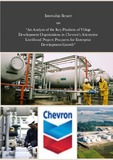| dc.contributor.advisor | Khan, Tahsan Rahman | |
| dc.contributor.author | Sarkar, Cathy Bipasha | |
| dc.date.accessioned | 2015-07-07T07:56:36Z | |
| dc.date.available | 2015-07-07T07:56:36Z | |
| dc.date.copyright | 2015 | |
| dc.date.issued | 2015-04-22 | |
| dc.identifier.other | ID 10104095 | |
| dc.identifier.uri | http://hdl.handle.net/10361/4226 | |
| dc.description | This internship report is submitted in a partial fulfillment of the requirements for the degree of Bachelor of Business Administration, 2015. | en_US |
| dc.description | Cataloged from PDF version of Internship report. | |
| dc.description | Includes bibliographical references (page 39). | |
| dc.description.abstract | This internship report is based on the Corporate Social Responsibilities of Chevron Bangladesh and how a single project named Alternative Livelihood Project can benefit the local community people where the company operates its businesses. In the beginning of the report the industry and company background, organization structure and vision for the future are being presented. In the following chapter, there is a brief description of my internship experience of four months as an intern for Government Affairs Department followed by the chapters where the community engagement programs of Chevron Bangladesh is explained. Some marketing analysis of the key products of the Village Development Organization is also illustrated here in the report. Finally the report concludes by suggesting some recommendations for the Village Development Organization of Alternative Livelihood Project.
Chevron defines its corporate social responsibilities as Community Engagement. The company believes that since they are operating in some parts of Sylhet area, they are socially responsible for the betterment of those local people‟s lives. In order to enrich their lives and contribute to the community, Chevron provides different community engagement programs which in theoretical language we call the Corporate Social Responsibilities or CSR activities. Village Development Organization falls under the Community Engagement Projects which helps the local community people to improve their livelihood and socio-economic condition. The members of these organizations take loans and receive training in different areas and after that they open up their own enterprises. In their enterprises, they conduct some marketing activities to sell the products. The paper illustrates the marketing activities and provides recommendation to improve their enterprises further.
Chevron‟s community development programs help over 30,000 people every year, through a focus on livelihoods, education and health. As part of their CSR activities, Chevron conducts blood donation campaign, building saplings near the roadsides; building homes for the local people, offering improve cooking stoves and solar panel. Chevron introduced an innovative idea that enables communities to raise the capital necessary to launch their own income-generating enterprises. Under the program, Chevron provided environmentally-friendly cooking and lighting solutions - improved stoves and solar panels - that allow people to save in monthly fuel and lighting costs. Most of Chevron‟s social investment programs in
Bangladesh focus on improving the quality of life and economic opportunities for the communities where they work. Through nongovernmental organizations, these livelihood development programs have organized the villagers into self-help groups and provided skills training and seed funds, enabling them to launch a wide variety of small and medium enterprises. Working with the nongovernmental organizations Health Service Delivery Project and the U.S. Agency for International Development, Chevron helped start three community clinics near the Bibiyana and Moulavi Bazar fields. Each year, these facilities provide about 72,000 treatments and services to their patients. Chevron is also helping to fund a five-year program that offers scholarships to students from across Asia and the Middle East who attend the Asian University for Women. Chevron has extended a three-year pre-primary program with Save the Children that will serve 1,800 out-of-school children in 60 schools in the Bibiyana and Jalalabad area.
Forming a Village Development Organization is a two phase process. The first phase is Initiation where the idea of creating the VDO takes place. The second phase is the Execution phase where the VDO starts their operation. For the sake of the project, three different kinds of emprises of the village development organization are portrayed throughout the paper. These are- fish culture, vegetable culture and poultry. By practicing this VDO method, the enterprise owners are getting the business benefits and earning more as an alternative source of income.
At the end of the report, some recommendations are provided for the betterment of the project such as- to record the income and expenses on a daily basis and introducing integrated cultivation methods. Through this village development organization, Chevron is introducing an alternative source of income for the local people and contributing to their economy as a part of their corporate social responsibility. | en_US |
| dc.description.statementofresponsibility | Cathy Bipasha Sarkar | |
| dc.format.extent | 43 pages | |
| dc.language.iso | en | en_US |
| dc.publisher | BRAC University | en_US |
| dc.rights | BRAC University Internship reports are protected by copyright. They may be viewed from this source for any purpose, but reproduction or distribution in any format is prohibited without written permission. | |
| dc.subject | Business administration | en_US |
| dc.title | An analysis of the key products of village development organizations in Chevron's alternative livelihood project : prospects for enterprise development growth | en_US |
| dc.type | Internship report | |
| dc.contributor.department | BRAC Business School, BRAC University | |
| dc.description.degree | B. Business Administration | |

